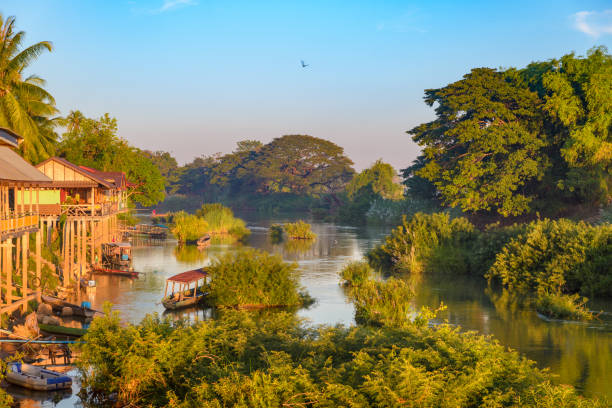Nestled in the southern reaches of Laos, Champasack Province is a treasure trove of history, spirituality, and natural beauty. Once the heart of a powerful kingdom, today it stands as a living museum of ancient temples, serene landscapes, and vibrant local traditions. Whether you're a history buff, nature lover, or cultural explorer, this province offers a deeply enriching travel experience.
The Historical Legacy of Champasack Province
The Kingdom of Champasack
Historically, Champasack Province was the center of the Kingdom of Champasack, which emerged in the early 18th century. Though eventually absorbed into the modern Lao state, its cultural and architectural legacy lives on. Ruins, temples, and colonial buildings stand as silent witnesses to the grandeur of its past.
Vat Phou: UNESCO World Heritage Site
At the heart of the province’s historical significance is Vat Phou, an ancient Khmer temple complex recognized as a UNESCO World Heritage Site. Older than Cambodia’s Angkor Wat, Vat Phou was once part of the Khmer Empire and is one of Southeast Asia’s oldest spiritual sites. Located at the base of Mount Phou Kao, the temple offers panoramic views and a spiritual ambiance that continues to draw visitors from across the globe.
Carved stone structures, weathered statues, and sacred shrines make Vat Phou a place of pilgrimage and deep reverence. The annual Vat Phou Festival, held in February, features traditional music, dances, and religious rituals, providing an immersive cultural experience.
Natural Wonders in Champasack Province
The 4,000 Islands (Si Phan Don)
One of the province’s most unique natural attractions is the Si Phan Don or “4,000 Islands” area in the Mekong River. During the dry season, hundreds of islands and islets emerge, creating a breathtaking mosaic of land and water. The most popular islands to visit are Don Khong, Don Det, and Don Khon.
These islands offer a laid-back vibe with charming bungalows, river views, and peaceful sunsets. You can enjoy kayaking, swimming, or cycling through sleepy villages and lush rice fields. It's also one of the few places in the world where you can catch a glimpse of the rare Irrawaddy dolphins.
Khone Phapheng Falls
South of Si Phan Don lies Khone Phapheng Falls, the largest waterfall in Southeast Asia by volume. This thundering cascade on the Mekong is both awe-inspiring and culturally significant. The falls represent the power of nature and have spiritual importance for the Lao people. It’s also a great spot for photography, and during the wet season, the power of the water is truly a sight to behold.
Bolaven Plateau
Stretching across parts of Champasack Province, the Bolaven Plateau is known for its cool climate, coffee plantations, and numerous waterfalls. The region’s volcanic soil makes it ideal for growing high-quality coffee, and tours of local plantations are available. Waterfalls such as Tad Fane, Tad Yuang, and Tad Lo are perfect for hiking and nature photography.
Cultural Richness of Champasack Province
Traditional Lao Life
Life in Champasack Province remains deeply rooted in tradition. Villagers engage in rice farming, weaving, and fishing, living in harmony with the rhythms of the seasons. The people are known for their hospitality, and staying in a village homestay can offer visitors a window into daily Lao life.
Markets brim with local produce, crafts, and freshly cooked street food. One must-try dish is or lam, a spicy stew made with herbs, vegetables, and meat—often buffalo or fish. Lao coffee, especially from the Bolaven Plateau, is another highlight.
Festivals and Spiritual Life
Festivals play a central role in the cultural life of Champasack Province. In addition to the Vat Phou Festival, the Lai Heua Fai (Festival of Lights) is celebrated during the end of Buddhist Lent. Colorful boats made of bamboo and banana leaves are floated down the river, carrying candles and prayers.
Temples, or wats, are central to community life. You’ll find many throughout the province, often decorated with gold leaf, dragon motifs, and serene Buddha statues. Visitors are welcome, though modest dress and respectful behavior are expected.
Responsible Travel in Champasack Province
Tourism in Champasack Province is still relatively low-impact compared to neighboring countries, making it an excellent destination for sustainable travel. Local initiatives focus on preserving nature, protecting endangered species like the Irrawaddy dolphins, and promoting community-based tourism.
Eco-lodges and homestays help support local families and reduce the environmental footprint of your trip. Travelers are encouraged to respect cultural norms, avoid single-use plastics, and support businesses that give back to the community.
Getting There and Getting Around
How to Reach Champasack Province
The provincial capital, Pakse, is the main gateway to Champasack Province. Pakse has a domestic airport with flights from Vientiane and Luang Prabang. Buses and minivans connect Pakse with other parts of Laos, as well as with Thailand and Cambodia.
From Pakse, visitors can rent motorbikes or hire tuk-tuks to explore nearby attractions. Riverboats are also popular for reaching the 4,000 Islands region.
Best Time to Visit
The best time to visit Champasack Province is during the dry season from November to March, when temperatures are cooler and the skies are clear. This is ideal for outdoor activities like hiking, cycling, and temple visits. The rainy season (May to October) brings lush greenery but may hinder travel to more remote areas.
Conclusion
Champasack Province is a hidden gem in Laos that invites travelers to slow down and immerse themselves in history, nature, and culture. From the ancient stones of Vat Phou to the tranquil waters of the 4,000 Islands, every corner tells a story of resilience, beauty, and spiritual depth.
With its blend of sacred sites, scenic wonders, and rich traditions, Champasack Province offers a journey not just through space but through time. For anyone seeking a meaningful travel experience in Southeast Asia, this province is not to be missed.
Comments